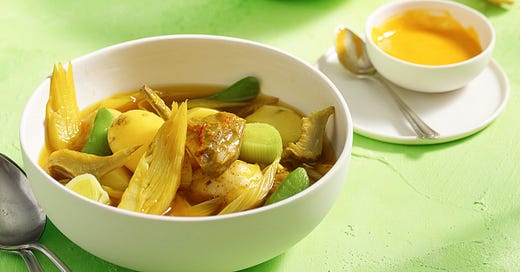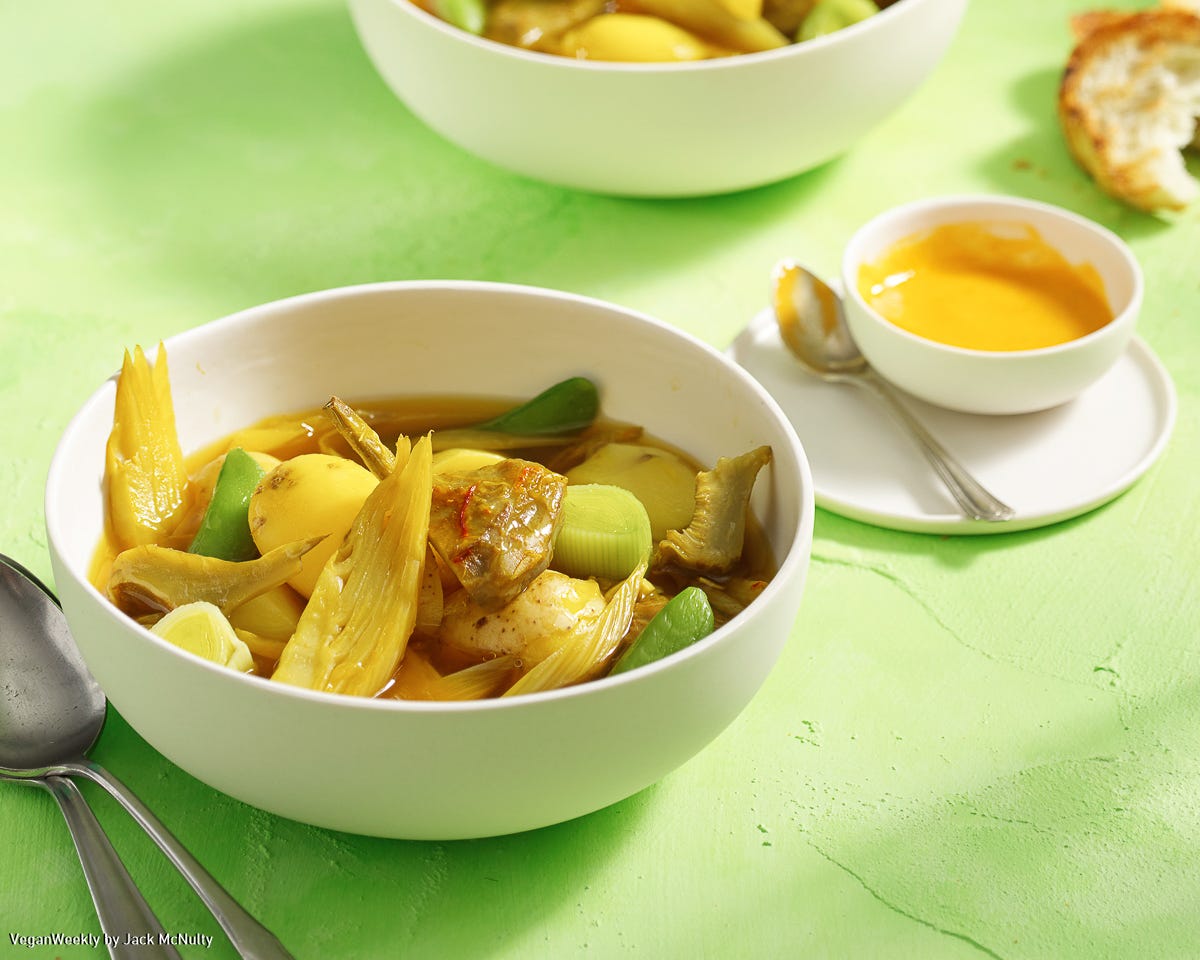La Bouillabaisse du Pauvres
It’s based on the Provencal classic, delicious in every way imaginable, and it retains the soul of the traditional preparation.
La Bouillabaisse du Pauvres, or poor man’s bouillabaisse as it’s roughly translated, is a recipe not easily found in cookbooks – regional, international, or specialty vegan books. It is a home cook’s recipe, born from the essence of the traditional French Provencal classic Bouillabaisse.
This dish is naturally plant-based, apart from some variations that include a poached egg. It is big and bold, filled with nutritious goodness, delicious in every way imaginable, and it retains the soul of the more traditional version served in every Marseille restaurant.
Despite all the positives, it's worth questioning the traditional perception of this dish. Even the name, 'La Bouillabaisse du Pauvres ', feels discriminatory. Why is a dish filled with delicious vegetables in a tasty broth considered poor? And poor man’s...what is that, other than a standardized generic term to imply people? Isn’t the title a thinly veiled slap at those who make this dish – the ones who do not have access to freshly caught fish or those choosing to avoid animal proteins? These are questions that invite us to reconsider our understanding of the culinary classic and the plant-based cousin.
The Story of Bouillabaisse
Food historians and cookbook authors paint a romantic picture of how the original preparation was born into the world. Here’s how Larousse described it in Gastronomique, “Bouillabaisse was originally cooked on the beach by fishermen, who used a large cauldron over a wood fire to cook the fish that was least suitable for market.” He described a bouillabaisse prepared from rockfish, scorpion fish, and the occasional bits of shellfish for refinement. The broth included onions, leeks, fennel, and potatoes. It was flavored with olive oil, spices – predominantly saffron – and orange zest.
The name bouillabaisse also lends a clue as to how this dish was prepared. The word is a contraction of two verbs, bouillir (to boil) and abaisser (to reduce), which implies that the name is more of a rapid cooking method than an actual recipe. Indeed, this was more a way of cooking vegetables and aromatics and flavoring the broth with fish, which would have been cooked in stages and removed once cooked. The fish and the stew were traditionally served separately, with the soupy stew poured onto slices of dried bread and the fish presented on large platters so the diner could decide what to eat and when.
Of course, as the soup gained popularity and began appearing in restaurants all along the Provencal coast, variations in cooking style and ingredients morphed into countless versions of bouillabaisse. Some included tomatoes and white wine. Some used oily fish, like sardines. Others used cod – even dried cod. One variation even uses cuttlefish and their ink to produce a black bouillabaisse.
Today, most restaurants use fish from other parts of the world, primarily farm-raised, because of the overfishing of the Mediterranean. Gone forever are the days when fishermen gathered together on a beach to cook the bits that could not be sold in the markets while sharing tall tales of an overabundance of fish that would one day make them rich.
Sadly, this is an example of a recipe nearing extinction because of its popularity...and man’s insistence on turning a local preparation into something worldwide.
The “Poor Man’s” Variation
High fish prices and access to fresh fish probably drove the creation of the Poor Man’s variation in Provence. The traditional bouillabaisse was a local seaside offering, and getting fresh fish to the difficult-to-reach nearby mountains was not simple...or cheap. Consequently, the mountain dwellers made a variation of the dish without fish; they emphasized fresh and local vegetables instead.
The fishless version retained the same idea of the classic preparation and preserved the soul of the dish by using potatoes, leeks, fennel, onions, and the classic aromatics of saffron, thyme, and orange peel. It is rarely found in restaurants and often ignored in cookbooks that feature French provincial cooking.
As to the name given to this variation...well, that seems to be a derogatory name given to those living in the hillside villages by those living along the coastal regions, thereby branding fish consumption as a kind of entitlement.
Ironically, the traditional fish version became so popular that it gained a worldwide cult status – a must-eat when visiting places like Marseille. But its popularity also contributed to overfishing the Mediterranean, which is now in a severe state of depletion. Consequently, fishless versions of this classic are on the rise, often filling the corners of the internet with “the next new thing.”
Breaking From Tradition
My version of bouillabaisse stands out from the traditional Marseilles recipe, which is widely considered the 'authentic' one. However, as with any traditional recipe, there are many variations. I am confident that my take on this classic dish is just as delicious and unique as those living in the hillside villages with significantly different terroir and culinary traditions from those of the coast.
And if someone asks me, “Are you really calling this dish a bouillabaisse just because you chucked some vegetables into a broth and flavored it with saffron and orange zest?” I shall reply, “Yes – it is a glorious interpretation I call La Bouillabaisse Pour Tout La Monde – Bouillabaisse for Everyone. And I serve it with my vegan variation of Rouille.”
This Week’s Recipes…
Anyone can look at the index of my published recipes, but the links are restricted to those who support my work through a paid subscription. Please consider subscribing or updating your current subscription…or contact me if you want to organize a free trial.
La Bouillabaisse du Pauvres
This plant-based version of Bouillabaisse retains the soul of the more traditional preparation. The robust broth is flavored with hints of saffron, orange zest, thyme, and bay leaf. Potatoes, leek, fennel, onions, and garlic are traditional ingredients in most authentic recipes. The artichoke hearts and sugar peas add more plant flavors and textures, but other than that, the base of the dish is authentic.
Rouille
This simple-to-prepare variation of the Southwestern French classic is rich and flavorful.
Rouille can be used as a spread to add a zesty kick to a sandwich or as a dip for raw vegetables. It also pairs perfectly with poached or roasted asparagus, artichokes, or steamed potatoes. And, of course, rouille is an absolute must as an accompaniment to Bouillabaisse du Pauvre.
Share Your Thoughts…
I always appreciate hearing from my readers, so feel free to comment and let me know your thoughts.
Have you ever heard of, or tasted, a plant-based bouillabaisse?
What are your thoughts on food extinction?
Share as much or as little as you want…
There are lots of ways to join the conversation and offer your thoughts. Jump onto Substack Notes and comment or restack this article (or even a portion)…or hit the button below and leave a comment at the bottom of this article.
Coming Next... Seeking Ancient Secrets to Making Authentic Injera
Previously in my series on alternative Grains:
Subscribe now to ensure you get my recipe ideas and plant-based food stories delivered to you.
All recipes are viewable, printable, and fully accessible to paid subscribers only. Everyone can access my Recipe Index to see what I’m publishing.
Social Media
Catch up with me on social media…
Facebook ¦ Instagram ¦ LinkedIn ¦







Love bouillabaisse! My dear friend Barb used to make fantastic ones and the yummiest potage parmentier. I think you two would get along. The way you understand veggies and how to prepare them never ceases to amaze me.
My family and I did have bouillabaisse in Marseilles a few years ago. It was a windy day in late December. The restaurant was ridiculously expensive (a ripoff, really) and the vibe from the staff was...disdainful? The bouillabaisse was good, but what we really loved was the rouille. It bums me out to think that the fish probably came from afar. I really like the sound of your veg take. In the mean time, I think I will whip up a batch of your rouille, as I have some farmers' market asparagus waiting to be roasted or grilled. Thanks for the inspiration.